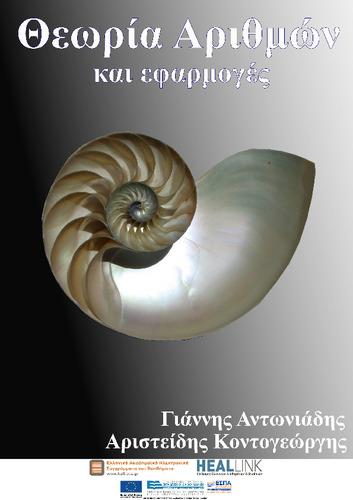| Title Details: | |
|
Number Theory and Applications |
|
| Authors: |
Antoniadis, Ioannis Kontogeorgis, Aristeidis |
| Reviewer: |
Theochari Apostolidou, Theodora |
| Subject: | MATHEMATICS AND COMPUTER SCIENCE > MATHEMATICS > NUMBER THEORY |
| Keywords: |
Prime Numbers
Diophantine Equations Congruences Quadratic Residues Law Of Quadratic Reciprocity Primitive Roots Indexes Primality Testing Factorization Continued Fractions Pell Equation Quadratic Forms Quadratic Number Fields Coding Theory Integral Basis Discriminant Fundamental Unit Decomposition Law Class Number Pseudoprimes Carmichael Numbers Jacobi Symbol L-series Legendre Symbol Fibonacci And Lucas Numbers Cryptography |
| Description: | |
| Abstract: |
This book is an introduction to number theory. Emphasis has been given to the historical development of the ideas and to applications. The book covers the teaching needs of all Mathematics departments in Greece. Until the ninth chapter only elementary tools are needed.
Last chapter requires some knowledge of algebra and Galois theory. Number theory for centuries was considered as part of "pure mathematics". The last 35 years many applications of number theory to cryptography and coding theory were discovered, and some of these applications are explained. The book is divided into two parts. The first part is devoted to the arithmetic of natural numbers and the second part to the arithmetic of irrational quantities. |
| Table of Contents: |
Arithmetic of Rational number
Divisibility and primes 1.1 Integers 1.2 Divisibility 1.3 Prime numbers 1.4 Bertrand's principle 1.5 GCD and LCM 1.6 Euclid's algorithm 1.7 Main theorem of arithmetic Diophantine equations 2.1 Introduction 2.2 Linear Diophantine equations 2.3 Pythagorean triples 3 Named Integers 3.1 Friends 3.2 Perfect numbers 3.3 Factorization and cryptography 4 Congruences 4.1 Introducion 4.2 Phi function 4.3 Systems of congruences 4.4 Applications 4.5 Raising in power and square root 4.6 Cryptography 4.7 Higher congruences 4.8 Factorization 4.9 Algorithms 5 Quadratic residues 5.1 Quadratic congruences 5.2 Quadratic reciprocity law 5.3 Composites 5.4 n-residues, roots, indices II Irrational numbers 6 Fibonacci numbers 6.1 Fibonacci numbers 6.2 Lucas Numbrs 6.4 Lucas sequences 7 Continued fractions 7.1 Continued fractions of rationals 7.2 Convergents 7.3 Linear equations 7.4 Continued freactions of reals 7.5 Best aproximation 7.6 Congruent numbers 7.7 Periodic continued fractions 7.8 Factorization 7.9 Continued fraction of e 7.10 Historical notes 8 Η Pell's equation 8.1 Introduction 8.2 Pell's equation 8.3 Generalized Pell's equation 8.4 Historical notes 9 Quadratic forms 9.1 Introduction 9.2 Equivalent forms 9.3 Representation of integes 9.4 Number of representations 9.5 Historical notes 10 Quadratic number fields 10.1 Arithmetic of Gaussian Integers 10.2 Algebraic integers 10.3 Basis and discriminant 10.4 The group of units 10.5 Decomposition law 10.6 Ideals and class number 10.7 Applications |
| Linguistic Editors: |
Kalliaras, Dimitris |
| Type: |
Undergraduate textbook |
| Creation Date: | 08-10-2015 |
| Item Details: | |
| ISBN |
978-618-82124-5-9 |
| License: |
http://creativecommons.org/licenses/by-nc-nd/3.0/gr |
| Handle | http://hdl.handle.net/11419/107 |
| Bibliographic Reference: | Antoniadis, I., & Kontogeorgis, A. (2015). Number Theory and Applications [Undergraduate textbook]. Kallipos, Open Academic Editions. https://hdl.handle.net/11419/107 |
| Language: |
Greek |
| Consists of: |
1. Divisibility and prime numbers 2. Diopantine Equations 3. Special Integers, cryptography and coding theory 4. Congruences 5. Quadratic residues , roots, indices and applications 6. Fibonacci numbers 7. Pell's equation 8. Quadratic forms 9. Quadratic number fields 10. Continuous Fractions 11. Number Theory and Applications: Annex A 12. Number Theory and Applications: Annex B |
| Number of pages |
250 |
| Publication Origin: |
Kallipos, Open Academic Editions |


